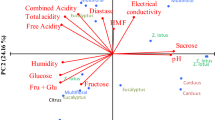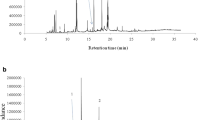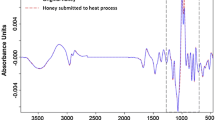Abstract
The physicochemical characterization and thermal profile of honeys produced by stingless bees are poorly known, mainly due to the high diversity of flora mellifera and to the low production that is inherent of these species. The objective of this study was to determine the physicochemical characteristics of five samples of honey from bees from the species Melipona seminigra merrillae of Amazonas State, Brazil. The thermal degradation profile of these honey samples was evaluated by thermogravimetry in order to contribute with the establishment of a quality standard of honeys produced from Brazilian stingless bees. Thus, the following analyses were performed: reducing sugars, moisture, hydroxymethylfurfural, protein, ash, pH, and acidity. The results showed that the current legislation concerning the honey of Apis mellifera is not an appropriate standard for all the properties analyzed, reinforcing the need for a honey standard including the honeys of all Brazilian bees. The honey samples displayed similar thermal degradation profiles, with the thermal process starting at room temperature and ending at a temperature next to 600 °C.



Similar content being viewed by others
References
Specifications from Normative Instruction number 11 of October 20, 2000. Brazil. Ministry of Agriculture, Livestock and Food Supply; Normative Instruction number 11 of October 20, 2000, Diário Oficial da União, October 23, 2000.
AL-Mamary M, Al-Meeri A, Al-Habori M. Antioxidant activities and total phenolics of different types of honey. Nutr Res. 2002;22:1041–47.
Küçük M, Kolaili S, Karaoğlu S, Ulusoy E, Baltaci C, Candan F. Biological activities and chemical composition of three honeys of different types from Anatolia. Food Chem. 2007;100:526–34.
Arráez-Román D, Gómez-Caravaca AM, Gómez-Romero M, Segura-Carratero A, Fernández-Gutiérrez A. Identification of phenolic compounds in rosemary honey using solid-phase extraction by capillary electrophoresis–electrospray ionization-mass spectrometry. J Pharm Biom Anal. 2006;41:1648–56.
Baltrušaityté V, Venskutonis PR, Čeksteryté V. Radical scavenging activity of different floral origin honey and bee bread phenolic extracts. Food Chem. 2007;10:502–14.
Acquarone C, Buera P, Elizalde B. Pattern of pH and electrical conductivity upon honey dilution as a complementary tool for discriminating geographical origin of honeys. Food Chem. 2007;101:03–695.
Azeredo LC, Azeredo MAA, Souza ASR, Dutra VML. Protein contents and physicochemical properties in honey samples of Apis mellifera of different floral origins. Food Chem. 2003;80:249–54.
Vit P, Medina M, Enriquez ME. Quality standards for medicinal uses of Meliponinae honey in Guatemala, Mexico and Venezuela. Bee World. 2004;85:2–5.
Marques-Souza AC, Absy ML, Kerr WE, Peralta FJA. Pollen collected by two Meliponini species (Hymenoptera, Apidae) from Amazonas State, Brazil. Rev Bras Biol. 1995;55:855–64.
Association of Official Analytical Chemists (AOAC). Official methods of analysis, supl. 2. 15th ed. Washington, DC: AOAC; 1990.
Anaceleto DA, Souza BA, Marchini LC, Moreti ACCC. Composition of the honey of samples originated from Jataí bees (Tetragonisca angustula latreille, 1811). Cienc Tecnol Aliment. 2009;29:535–41.
Souza RCS, Yuyama LKO, Aguiar JPL. Nutritional value of honey and pollen of stingerless bees of the Amazonian region. Acta Amaz. 2004;34:333–6.
Souza BA, Marchini LC, Oda-Souza M, Carvalho CAL, Alves RGO. Characterization of honey produced by species of Melipona Illiger, 1806 (Apidae: Meliponini) from the northeast area of Brazil: 1. Physico-chemical characteristics. Quim Nova. 2009;32:303–8.
Alves RMO, Carvalho CAL, Souza BA, Sodré GS, Marchini LC. Physico-chemical characteristics of honey samples of stingless bee Melipona mandacaia Smith (Hymenoptera: Apidae). Cienc Tecnol Aliment. 2005;25:644–50.
Codex Alimentarius Commission. Codex standards for sugars (honey). FAO: Rome; 1989.
White JW, Subers MH, Schepartz I. The identification of inhibine the antibacterial factor in honey, as hydrogen peroxide and its origin in a honey glucose–oxidase system. Am Bee J. 1963;73:430–1.
Terrab A, Recamales AF, Hernanz D, Heredia FJ. Characterisation of Spanish thyme honeys by their physicochemical characteristics and mineral contents. Food Chem. 2004;88:537–42.
Finola MS, Lasangno MC, Marioli JM. Microbiological and chemical characterization of honeys from central Argentina. Food Chem. 2007;100:1649–53.
De Rodríguez GO, Ferrer BS, Ferrer A, Rodríguez B. Characterization of honey produced in Venezuela. Food Chem. 2004;84:499–502.
Cortopassi-Laurino M, Gelli DS. Analyse pollinique, propriétés physico-chimiques et action antibactérienne des miels d’abeilles africanisées Apis mellifera et de Méliponinés du Brésil. Apidologie. 1991;22:61–73.
Anklam E. A review of the analytical methods to determine the geographical and botanical origin of honey. Food Chem. 1998;63:549–62.
Cordella C, Faucon JP, Cabrol-Bass D, Sbirrazzuoli N. Application of DSC as a tool for honey floral species characterization and adulteration detection. J Therm Anal Calorm. 2003;71:279–90.
Schäffer B, Keller B, Szakály Z, Lőrinczy D. Examination of a coffee product enriched with calcium by the isoperibolic method. J Therm Anal Calorim. 2012;108:171–5.
Tomassetti M, Campanella L, Aureli T. Thermogravimetric analysis of some spices and commercial food products: comparison with other analytical methods for moisture content determination. Thermochim Acta. 1989;143:15–23.
Macêdo RO, Moura OM, Souza AG, Macêdo AMC. Comparative studies on some analytical methods: thermal decomposition of powder milk. J Therm Anal Calorim. 1997;49:857–62.
Acknowledgments
The authors acknowledge the Brazilian agencies FAPEAM—Fundação de Amparo à Pesquisa do Estado do Amazonas, MCT, and FINEP for the financial support.
Author information
Authors and Affiliations
Corresponding author
Rights and permissions
About this article
Cite this article
Silva, I.A.A., Souza, A.L., Cordeiro, A.M.T.M. et al. Thermal degradation of honeys and evaluation of physicochemical properties. J Therm Anal Calorim 114, 353–358 (2013). https://doi.org/10.1007/s10973-012-2926-x
Received:
Accepted:
Published:
Issue Date:
DOI: https://doi.org/10.1007/s10973-012-2926-x




